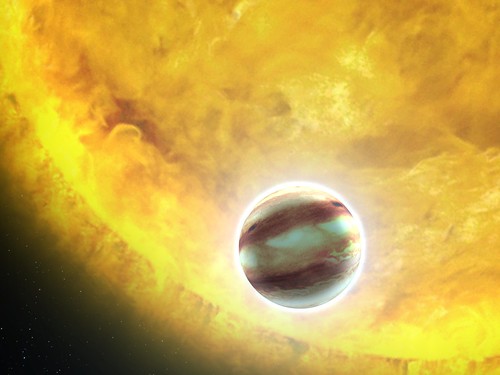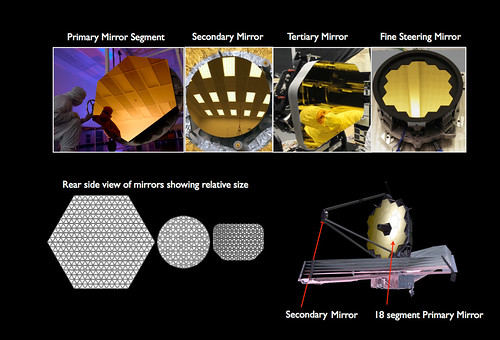Awesomeness Round-up – 7/11/11
- By Faith Tucker
- July 11, 2011
- 1 Comment
[Sara’s note: You might notice that this week’s awesomeness round-up (which covers two whole weeks of news – that’s a lot of awesomeness in one place!) is missing one of the most awesome things that happened – the launch of Space Shuttle Atlantis. Fear not, that will get its own separate post, since Blueshift’s very own Faith Tucker was down there and captured tons of photos and video of the launch!]
Galactic cannablism may be losing its popularity (along with every other form of cannablism, for that matter) as a recent Spitzer study suggests a very different mechanism for galaxy growth. “Galaxies once thought of as voracious tigers are more like grazing cows, according to a new study using NASA’s Spitzer Space Telescope.” Previously, astronomers believed galaxies to grow through violent collisions with other galaxies from which they would collect stray gas, igniting a new burst of star formation. But perhaps galaxy growth is a much more sedate process as steady streams of gas slowly feed these galactic beasts.
![Large Image: Galaxies Collide in the Antennae Galaxies (NASA, Chandra, Hubble, Spitzer, 08/05/10) [Explored]](http://farm5.static.flickr.com/4073/4864714198_a581043b00.jpg)
A multi-mavelength image of the Antennae Galaxies collide dramatically, credit: X-ray: NASA/CXC/SAO/J.DePasquale; IR: NASA/JPL-Caltech; Optical: NASA/STScI
Picture a neutron star that is the size of Washington D.C., two times the mass of the Sun and spinning nearly 21 times each second! And now picture this neutron star careening past its hot blue supergiant stellar companion, which is many times the size, mass and temperature of the Sun. This “odd couple” is a rare type of binary system in which every 3.4 years the dense neutron star swings past the supergiant and emits an extraordinary amount of gamma rays. Astronomers all over the world observed the last close encounter in December of 2010 and have released their exciting results.

Credit: NASA, ESA, and G. Bacon (STScI)
Hubble captured its one millionth scientific observation, reminding us once again just how revolutionary our beloved space telescope has been over the last 21+ years. Below is a video of 200 of Hubble’s most famous images, courtesy of the Geeked on Goddard blog.

Image credit: ESA/NASA-JPL/UCL/STScI
The universe is a housekeeper’s worst nightmare – it’s chock full of dust. But unlike everyday household dust, this cosmic dust is something that scientists are very interested in studying. One of their biggest questions: where did it come from? New observations taken by the Herschel Space Telescope suggest that dust in the early universe was created when massive stars blew up in supernova explosions. The key to solving this cosmic mystery was Herschel’s observations of cold dust around popular supernova remnant SN1987A. What, you though there was just one kind of dust out there? The Spitzer Space Telescope saw warm dust that pre-dates the supernova, but Herschel’s discovery of large quantities of cooling dust formed after the explosion have helped astronomers better understand both supernovae and the origins of our dusty universe.

Image credit: ESA/NASA-JPL/UCL/STScI
On June 27th a school bus-size asteroid called 2011 MD whizzed a mere 7,600 mi above the south Atlantic. Although not a terribly unusual event in itself, it was surprising that we didn’t spot this neighbor till it was only five days away. The Earth gets the occasional visit such as this and will have many more (such as a 400-m wide asteroid that is expected to pass just inside the Moon’s orbit in November), but don’t worry, we won’t be requiring any maverick oil drillers to save the planet from impending doom any time soon.
The James Webb posted this image of the telescope’s various mirrors. As of last week, all 18 of the primary mirror segments have completed their final polishing and 6 of those have finished their cryogenic testing!

Credit: NASA/Ball Aerospace/Tinsley
This image shows the four different types of mirrors on the Webb telescope. From left to right are a primary mirror segment, the secondary mirror, tertiary mirror and the fine steering mirror. The bottom right shows an artist’s conception of the Webb telescope optics with its 18 primary mirror segments. On the bottom row are the three different mirror segments shown on the same scale and seen from the rear to illustrate the honeycomb structure that makes this mirrors both very light and mechanically stiff.



Omnius Spiritus Specs!